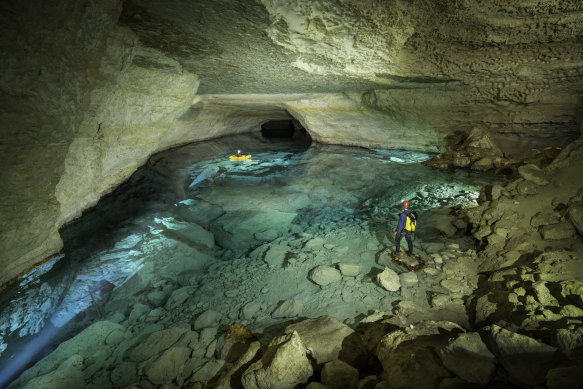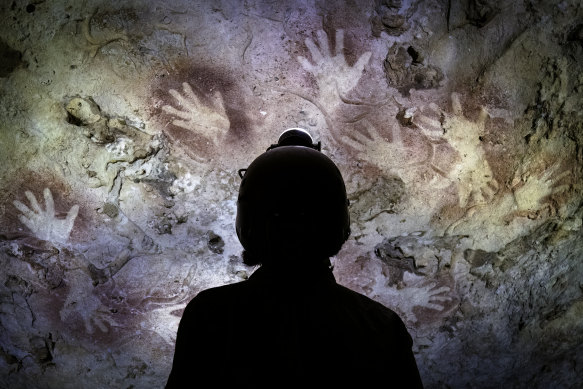By Emma Young
A group of scientists say a $100 billion wind and solar project proposed for Western Australia will destroy an area that should be protected as an irreplaceable global treasure.
They have urged the public to use an initial public comment period, which opened on Monday and will close this Sunday, to demand a full public environmental review.

This cave lies a few kilometres from the proposed ammonia production plant and storage facility. Credit: Stefan & Bronwen Eberhard
The Western Green Energy Hub would build 3000 wind turbines and six million solar panels in WA to power production of hydrogen and ammonia, mostly for export, though potentially leaving some for local use.
The project would start at the South Australian border and stretch west along the Nullarbor Plain for hundreds of kilometres.
The plans from multinationals InterContinental Energy, CWP Global and Mirning Green Energy were lodged with the state’s Environmental Protection Authority this week. They would take decades to build and, if completed, would deliver 70 gigawatts of renewable energy generation – about the same capacity as the entire eastern seaboard’s electricity grid.
Scientists are voicing alarm about an “increasing incidence of environmental destruction to make way for large-scale renewables projects in nature hotspots”.
In a joint statement, they say a 1992 Commonwealth-commissioned report determined that this cave system met four World Heritage integrity criteria based solely on its nature, even before considering its cultural heritage or marine ecosystems.
They say only one criterion is needed for World Heritage listing and the South Australian side of this system is already being considered for nomination.
They say documents the consortium lodged with the EPA fail to consider cave landforms and underground fauna as key environmental factors, which they say is “egregiously remiss” – but proponents say the project has been designed with impact-avoidance in mind and there will be “considerable flexibility” in where infrastructure will be situated.
Dr Stefan Eberhard, a cave scientist and co-founder of Save the Nullarbor, has been exploring and studying the Nullarbor’s caves for more than 40 years. He said the Nullarbor Plain was the world’s largest arid limestone karst system, “a spectacular hidden world of ancient caves and rock holes of staggering dimensions, beauty, scientific values, and priceless cultural importance.”
The development proposes to clear up to 27,000 hectares of land and partially clear another 77,000 hectares and install, as well as the turbines and solar farms, electrolysers, data centres, power lines, pumping and cooling systems, an ammonia production facility, workshops and fabrication facilities and worker villages to home around 8000 people. An infrastructure corridor is planned to the coast through the newly announced South Coast Marine Park.

These ochre hand stencils in a Nullarbor cave indicate the traditional ownership of the Mirning Peoples who used the cave system for shelter, ceremony, creative expression and a source of water and flint for tools. Credit: Stefan & Bronwen Eberhard
Eberhard said this infrastructure and clearing would also damage fragile soils and potentially change inputs to the underground caves in which rare and unique species lived.
Environmental law expert Dr Gerry Bates contributed to the group statement, saying Australia’s environment minister had both a legal ability and obligation to identify the area for further protections.
WGEH chief executive Dr Ray Macdonald said an absolute priority of the project was “avoidance of impact”, which was fundamental in respecting and protecting the environment.
“In relation to cave and karst features, we have already undertaken significant identification of location studies,” he said.
“This, and intentional buffer zones, will help ensure we have no physical overlay with, nor impact on, these environments. Ongoing studies will continue to ensure further identification of any sensitivities and maintain our principle of avoidance.
“While the WGEH renewables project has a large perimeter of land, around 95 per cent of the total project area will remain untouched. With respect to the 5 per cent that will be utilised, there is considerable flexibility in where solar panels, wind turbines and related infrastructure can be situated.”
Start the day with a summary of the day’s most important and interesting stories, analysis and insights. Sign up for our Morning Edition newsletter.